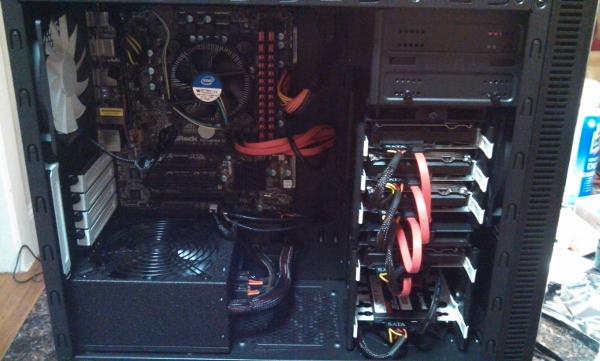When it comes to digitizing, storing, and playing back multimedia: nothing compares to having an actual computer in your entertainment center. No console or proprietary media device can compete with the flexibility, power, and expressive input that a regular PC allows.
Thankfully building a home theater PC (HTPC) with ~10TB of storage will only set you back about $1200 these days, with storage prices always falling. Some expertise with hardware and operating systems is required, however many communities and guides can be found online. Building a media PC can be an excellent platform for learning about storage, media formats, and backup concerns.
Parts
- Case: selected not only for the number of drives it can hold, but for how quiet and form fitting the design is.
- CPU: For basic media boxes that won’t be doing video capture or modern 3d gaming, a CPU with an integrated GPU will suffice, and save from needing to buy (or fit into a case!) a graphics card.
- Motherboard: Motherboards can now be found with 6-12 SATA ports and either real or virtual RAID controllers built in. This greatly simplifies storage concern and saves on another PCI card.
- RAM: 8GB of “high performance” (but none of that “EXTREME” nonsense, or RAM with coolers twice the size of the chips) memory.
- SATA large capacity storage drives: As of this writing 4TB drives can be had for $150. Consider splurging for 2 spares and doing RAID6
- SSD medium capacity drive for operating system. Not a hard requirement, but it can boost performance of the entire system and simplify settin up and maintaining the storage array.
Our build
Here’s a (relatively out of date) list of parts for our build:
- Case: Fractal Design’s Define Mini This case wound up being larger than I expected, but not more than I needed. It has a little room to grow, and is exceptionally quiet, even with 5 spinning drives at work. Another unexpected delight was the cable tray built into the side of the case “under” the motherboard. The panel on that side also comes off, and a number of holes around the motherboard tray allow cables to be run in a separate (and hidden) space.
- CPU: Since I don’t do any video capture or plan to do any modern gaming on a living room television I went with a relatively new “integrated GPU” CPU. Specifically Intel’s i3-3225 Ivy Bridge CPU (with integrated Intel HD4000 GPU) . This CPU/GPU combo has been able to play every high def video I’ve thrown at it, even under the load of other encoding
- Motherboard: This was a bit of a tossup, since most of my favorite manufacturers have either changed ownership, names, or both over the past ~8 years since I’ve built a home PC (assisting IT has its material perks). I wound up selecting the AsRock H77M for it’s featureset, 6 SATA ports, RAID support, and other amenities.
- RAM: I went with 2x4GB of G.Skill Ripjaws series RAM. It won on price and not being wildly tacky.
- Storage drives: Amazon happened to run a deal on 3TB Seagate Barracuda’s which really started this whole build. I have monitoring enabled on the drives and the array, but no problems so far.
- Boot drive: I went with a Kingston V300 since it was on sale on NewEgg at the time. This drive doesn’t have to be reliable, and can be backed up onto the storage array.
Build
The actual build process was relatively straight forward, other than a number of rewirings in order to fully take advantage of the cable tray. If you’re new to PC building Tom’s Hardware has a pretty good guide for actually putting components together. As usual the only advice is: be wary of electrostatic shock, and DON’T FORGET THE THERMAL GREASE!
The BEAST
 Check out that cable job!
Check out that cable job!
Software
One aspect of building an HTPC that can be overwhelming is the sheer number of choices for software. Rather than view it as overwhelming, consider it for it’s freedom of choice. Once you find an established solution that works for you, make that your default, and never stop experimenting!
- OS: Entirely up to the comfort of the users. I would of course recommend Linux, however some especially draconian DRM schemes have yet to be implemented on Linux, meaning Netflix, Amazon Prime Video, and some other popular services are not available¹. Again the biggest influencing factor here should be user comfort.
- RAID: Yes, for consumer hardware in 2014, software RAID is a more than acceptable choice. For Linux users this means MD.
- Media Player: A program to play any and all file formats without its user interface getting in your way. Mplayer (an incredibly flexible media tool) and VLC (great at complex subtitles and handling multiple tracks) are always highly recommended.
- Media Center: The daily driver of a media box. There are many wonderful media center projects out there: XBMC, Plex, MythTV(a solid PVR too) and more. We’re currently using Plex’s hosted product for our media at home.
- Ripping Software: For backing up DVD media, nothing beats HandBrake
- Emulators: Don’t forget, most previous generation game consoles can be used via emulation software these days. With the hardware in this box we’re able to play all of our older console favorites from Atari to N64 without breaking a sweat. Getting ROMs is still a legal grey area, however even the Internet Archive will hook you up with torrents.
¹: Update 9/19: Apparently updates coming for the Linux NSS package will enable enough of the DRM that Netflix will now support Linux!